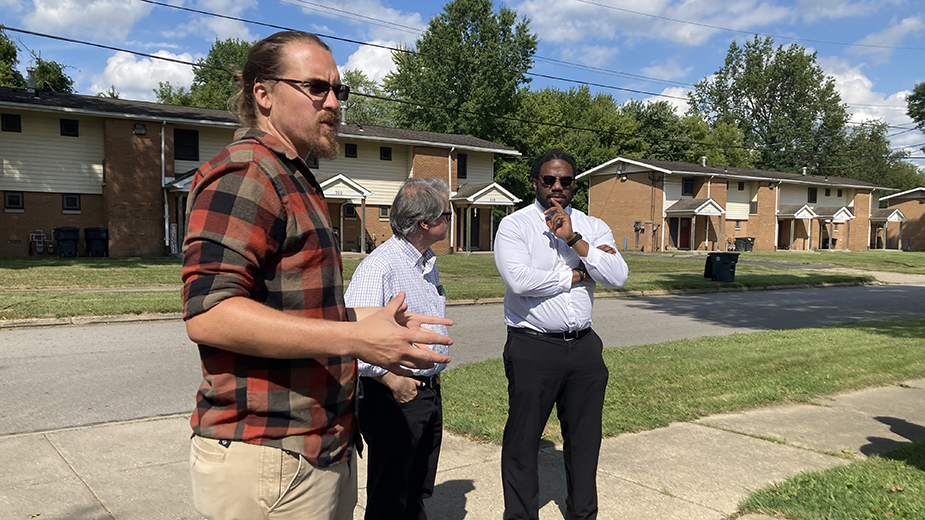WARREN, Ohio – Redevelopment of the Southwest neighborhood of Warren’s 6th Ward must strike a balance to provide needed housing while avoiding gentrification.
A group of Kent State University architecture students is in the beginning stages of designing solutions that will accomplish that.
Sixteen students and William T. Willoughby, associate professor at KSU’s College of Architecture and Environmental Design, toured the long-neglected neighborhood in mid-September.
The idea is for them to develop plans for new, affordable housing in that area, bordered by the Mahoning River and Tod Avenue (state Route 45).
Michael Keys, Warren’s community development director, said he and other city officials look forward to the infusion of new ideas from the perspective of a younger generation.
The students toured the area Sept. 11, visiting several sites including Deemer Park, the Highland Towers housing project, Trumbull Community Action Program, Second Baptist Church, Jefferson PK-8 School and the former RG Steel site.
The tour was coordinated by Wiley Runnestrand and Michael Martof, who along with Chuck George are principals of Sapientia Ventures LLC, a venture capital group that’s developing the West Warren Industrial Park project.
Runnestrand points to business growth in the area, including Foxconn and Ultium Cells, as well as the industrial park. Route 45 is an entry to the city, and people pass through the neighborhood on their way to and from those facilities. The creation of new, affordable housing in the area could entice workers at those companies, as well as those developed in the future, to live and raise their families in the city, Runnestrand says, rather than locating to another community.
Marvin L. Logan Jr., who lives in the neighborhood, graduated from Warren City Schools and is a KSU alumnus, joined the tour and explained some of the history of the neighborhood. Logan is the executive director of Oh Wow! The Roger & Gloria Jones Children’s Center for Science and Technology.
The area has seen population loss and divestment over the past several years, Logan says.
He cautions the students, though, against efforts similar to what was undertaken in Allentown, Pa., and Detroit. Those efforts resulted in gentrification and similar plans for the Warren neighborhood will meet opposition, Logan says.
The students and their professor also heard from the Rev. Todd Johnson, pastor of Second Baptist Church, the oldest Black Baptist church in the city. Johnson is also the city’s 1st Ward councilman.
The church is just down the street from Highland Terrace. Logan, who is a member of Second Baptist, credits the church for helping to keep crime down in the Highland Terrace neighborhood. The church and some of its members have also purchased properties in the neighborhood to try to preserve it.
Last year, Willoughby and a different cohort of his students presented suggestions to the city for redevelopment of the former St. Joseph Riverside Hospital site. Keys says those suggestions are being reviewed, and the redevelopment is in the very early stages.
The Sapientia principals also initiated the KSU students’ involvement in that project.
About a decade ago, Runnestrand, who formerly worked in the fundraising department at KSU’s architectural school, and Willoughby enlisted KSU students to design suggestions for the redevelopment of Phelps Street in downtown Youngstown. That led to the city hiring a design team to close the street to vehicles and changing it to a pedestrian walkway to the Youngstown Foundation Amphitheatre.
In the newest venture, the students also may consider making the Southwest neighborhood area friendlier to pedestrians and bicyclists.
Willoughby calls the lack of new, affordable housing the “missing middle,” the gap between single-family stand-alone homes and apartment towers. It includes a range of housing, including duplexes, townhouses and row houses.
He expects to return with the students in about a month. In the meantime, the students will develop what Willoughby calls “area plans” before they move on to site plans. Returning with the area plans will enable the students to get feedback from city residents.
The students then will be broken into smaller groups to design an overall plan for the neighborhood, including a variety of possibilities that will be presented for feedback.
Later in the semester, the students will work individually, designing portions of the project in more depth. They aim for a public presentation in mid-December, the end of the semester.
The plans will align with Warren’s 2021 Comprehensive Plan, as well as plans for recreational opportunities along the Mahoning River.
Willoughby envisions multiple-family housing for mixed incomes, providing new homes for current residents as well as attracting new residents to the city.
“I can see this becoming a model,” the professor says.
Pictured at top: Wiley Runnestrand, a principal of Sapientia Ventures LLC; William T. Willoughby, associate professor at Kent State University’s College of Architecture and Environmental Design; and Marvin Logan, executive director of Oh Wow! Children’s Center, took KSU students to the Highland Terrace housing project.
